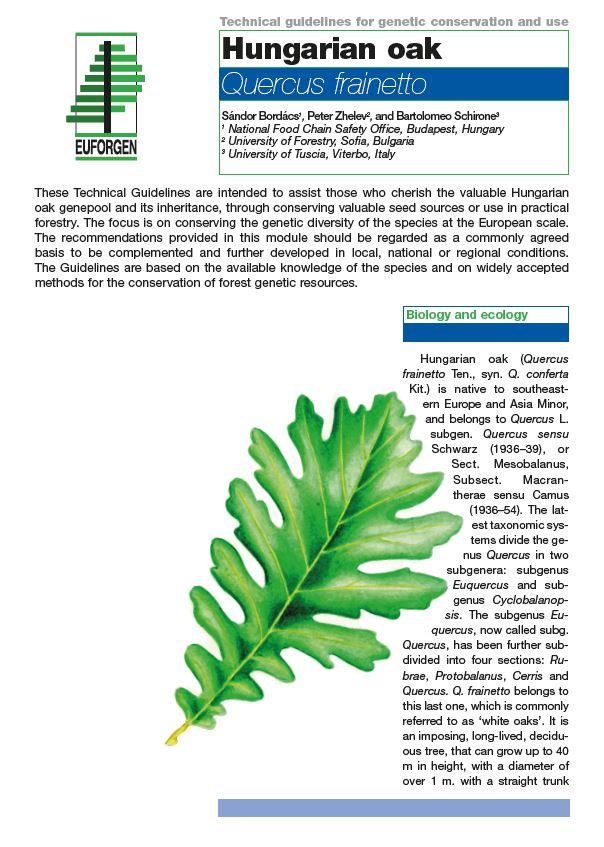Quercus frainetto - Technical guidelines for genetic conservation of Hungarian oak
For Q. frainetto, as a stand forming oak species, in situ conservation methods based on natural regeneration should generally be preferred. Hungarian oak usually grows in mixed stands with Q. cerris and Q.petraea and, due to their good resprouting ability, the coppice system has been predominantly used for ages. However, after a fast initial growth, accompanying species often overgrow and suffocate it. On the contrary, Q.frainetto grows well with high forest or in a coppice system where the number of stems per stump is reduced to one single stem, which would be by itself a good measure for the species’ in situ protection. It is recommended to convert coppiced Q. frainetto and Q. cerris mixed stands to high forests for 80–90 years. In the case of natural regeneration, a special method should be applied, by leaving 80–150 seed-bearing trees/ha (according to the size of the plants) for regeneration. High forests and coppice with single stems per stump of Q. frainetto can usually be regenerated naturally, but, when needed, direct seeding or planting of seedlings could also be applied.
When artificial regeneration is carried out according to the principles of genetic conservation, then the following requirements for the use of reproductive material must be observed:
- Preference should always be given to local material, unless results from provenance trials point to inferior quality or growth characteristics in the local population. Local material usually guarantees retention of the evolutionary and adaptive characteristics that have developed at a given site under specific conditions over generations. Lack of adaptability can lead to serious failures at any stage of the long lifespan of Hungarian oak and other forest tree species.
- If there is no local material available or if there are signs of inbreeding, then restoration may rely on the introduction of material from outside. Material from localities sharing the site conditions with the regeneration site should be preferred.
If in situ methods are not sufficient, ex situ conservation programmes should be used as well in order to preserve the endangered gene pool. Ex situ programmes should be adapted to the local conditions to incorporate genetic conservation criteria into forestry management, in order to guarantee the genetic quality of the materials used in plantations. Due to its adaptive potential, Hungarian oak might have an increasing role in present and future sub Mediterranean regions, which may be important in the context of climate change.
Since limited genetic information about Q. frainetto is available, it is recommended that genetic conservation programmes start with the following objectives: conservation of endangered, marginal populations and habitats of Q. frainetto; sampling the genetic diversity; establishment of Genetic Conservation Units based on long term autochthony, high biodiversity value and location in ecologically diverse regions of large populations (> 1000 individuals).
Authors: Sándor Bordács; Peter Zhelev Stoyanov; Bartolomeo Schirone
Journal/Series:
EUFORGEN Technical Guidelines for Genetic Conservation and Use
Publication Year: 2019
Publication Format: PDF
ISBN: 978-952-5980-61-5
Language: EN
Pages: 6 p.
EUFORGEN Publication Home EUFORGEN publications Technical guidelines Quercus frainetto

